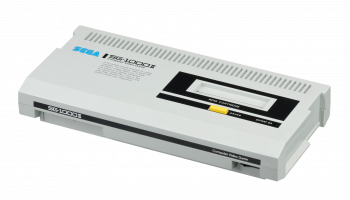SG-1000:SG-1000 Model Differences
There are two SG-1000 models, and one revision within these models.
Models + Revisions
Models are arranged chronologically.
Original SG-1000 (1983-1984)
The original SG-1000 was released in Japan on July 15, 1983. It is easily distinguished by its large aluminum nameplate, red pause button and hardwired SJ-200 joystick. The top of the console is made of cream-colored plastic with a separate gray/beige piece which surrounds the cartridge port. At the rear of the console are the RF out, channel select, power input, power switch, and a 24-pin card edge connector which is the expansion port; this port was later used for the SK-1100 keyboard. The SJ-200 joystick comes out of the left-hand side of the console; the right hand side features a DB9 connector for a second controller.
Most SG-1000s have a nameplate with blue trim, but some earlier consoles have black trim instead. These are colloquially known as the "Germany" models due to the nameplate's color scheme resembling the German flag.
Internally, the SG-1000 features rather flimsy construction with the single-sided main board only being held in by the four case screws. Alarmingly, the cartridge port is not properly secured to the board and is only held on by its solder joints. Due to the board being single-sided, it does not take much for the cartridge port to develop cracked solder joints, leading to poor reliability.
The original console also saw a release in New Zealand under the Grandstand brand, being released as the "Grandstand Sega 1000". These are mostly identical to the Japanese model save for the different nameplate and the use of a TMS9929 VDP, due to the lack of a PAL variant for the TMS9918 chip. These models have a separate board which converts the 9929's component video signals into composite, which is then fed into the RF modulator.
Othello Multivision FG-1000 (1983)
Released during 1983, the Othello Multivision is an officially licensed clone of the SG-1000 sold by toy and board game company Tsukuda Original. This unusual system features a built-in game of Othello and a built-in keyboard specifically made for playing that game. The Multivision also features 2 KB of RAM over the SG-1000's 1 KB and has a built-in joystick; there are no controller ports, even for a second player. At the rear of the console are the RF out, channel select, SG-1000 expansion port, power switch and AC adapter input. These are all arranged in the exact same order as the SG-1000.
Tsukuda Original also released their own games for the system, some of which take advantage of the extra kilobyte of RAM and so cannot be played on an SG-1000. However, all SG-1000 games are compatible on the Multivision.
Pioneer SD-G5 (1983)
This unusual variation of the SG-1000 was sold by Pioneer as an add-on for their "SEED" range of TVs, which were high-end displays meant to compete with the likes of Sony's ProFeel monitors. The SD-G5 plugs into a SEED monitor's expansion bay and is compatible with practically all SG-1000 games. Unlike any Sega hardware, the SD-G5 uses an 8-pin mini-DIN connector for its joystick, which is a Pioneer-branded version of the SJ-200. At the front of the SD-G5 is a badge advertising RGB support; presumably the SD-G5 has a TMS9928 VDP which has color difference signals that can be converted to RGB.
SD-G5 units are extremely rare, largely due to the fact that they were only designed for use with a particular set of expensive TV sets. Pioneer and Sega would collaborate again a decade later for the LaserActive, which featured a similar modular concept to Pioneer's SEED TVs.
SG-1000 II (1984-1985)
A year after the SG-1000's debut, Sega released a revised model known as the SG-1000 II, which set out to correct some of the flaws from the original system. It is primarily a cosmetic redesign with no hardware upgrades, with the expansion port and power switch being relocated to the front of the console and a controller port for player one. On the top, the cartridge port is offset to the right with a small yellow pause button below it. At the back are the RF out, channel select, controller ports and power input. The console was also bundled with new joypad controllers which snap onto the sides of the console for storage.
The SG-1000 II saw two different board revisions over its short life, though these are not readily apparent without a teardown or trained eye. Build quality was improved compared to the original console, as the main board is screwed down on each side of the cartridge port, and the cartridge port itself is reinforced onto the board with rivets.
Early SG-1000 IIs feature identical hardware to the original console, including a TMS9918 VDP and SN76489 audio chip. At some point during production, Sega revised the SG-1000 II and replaced these two chips with the 315-5066, a custom chip designed by Yamaha. This board variant is especially notable in that the 315-5066 has unused RGB and sync outputs, meaning that these consoles can be easily modified for RGB output. Despite this, the color palette used by the 315-5066 is slightly inaccurate compared to a TMS9918. The number of VRAM chips was also reduced from eight to two with this board revision.
Othello Multivision FG-2000 (1984)
Around the time of the SG-1000 II's release, Tsukuda Original released a slightly revised version of the Othello Multivision, model number FG-2000. The FG-2000 version of the Multivision is largely identical but has a slight blue-gray tinge to the case and blue keys compared to the original FG-1000's red. The built-in joystick was also replaced with a D-pad of sorts. Most importantly, the FG-2000 added a controller port for a second player and came packaged with a specially branded version of the SG-1000 II's SJ-150 gamepad.

